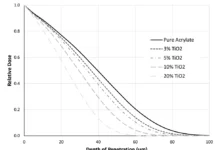by Stephen C. Lapin, Ph.D., Industry Consultant, SCLapin Consulting LLC
Question: How does electron beam curing fit with digital printing technology?
Answer: When most people think about electron beam (EB) curing for printing and packaging, they think about wide- and mid-web high-speed printing of folding cartons and flexible packaging. EB certainly is well established in these areas. Web offset is the dominant EB printing technology, with EB flexo making nice gains as wet-trapping inks and press technology continue to improve. But, what about digital printing? Is there a role for EB curing in digital printing technology?
Growth in Digital Printing
Digital printing technology is growing at an astounding rate. This includes digital printing stations integrated into conventional presses to add variable information and complete digital press solutions. Digital press technology is a great fit for short runs and customized print jobs, but break-even points for digital vs. conventional printing continue to grow as digital press speeds increase. There is almost no segment of the printing industry that is untouched by digital printing technology. This includes commercial printing, POP displays, signs, banners, decorative surfaces, building panels and floor tiles. You name it, and digital either already is established or making inroads. In the packaging world, digital already is well established in label printing and is growing for carton printing. Digital also has been introduced for printing on ridged packaging, including cans, bottles and cups.
Digital printing is only just beginning to be established in the flexible packaging world. There certainly is an opportunity for digital printed flexible packaging given the high number of SKUs, local brands and promotional packaging campaigns. EB technology could be an excellent fit for digital printed flexible packaging. The main factors that drive the use of EB in conventional package printing are consistent cure, low odor, low migration, excellent appearance and resistance properties. These same factors should help drive the use of EB in digital package printing.
Opportunities in technology and consumables
Most digital printing can be broadly classified into inkjet or electrographic imaging processes. There are a number of subclasses of each type. UV curing of inkjet inks is well established using mercury lamps and LED sources. Advantages of UV curing of inkjet include fast curing, excellent print quality, excellent adhesion to a variety of substrates and excellent resistance properties.
In order to jet properly, inkjet inks must be very low viscosity. This limits UV inkjet ink compositions to a relatively small selection of low molecular weight acrylate functional monomers. The use of these monomers can make it challenging to produce low-odor, low-migration inks. Additionally, photoinitiators that give fast curing of UV inkjet inks may not be ideal for low migration properties. Electron beam curing of inkjet inks eliminates the need for photoinitiators and may expand the selection of monomers that can be used while maintaining low migration properties. Another advantage of EB inkjet may be printing on porous substrates, such as fabrics, where the beam can penetrate and cure areas that are not easily penetrated by UV.
Much of the initial growth in inkjet package printing is occurring in narrow web formats. Sealed tube EB “lamp”-based systems (UV+EB Technology, 2016 Issue 2, p. 12) are ideal for narrow formats. Actively pumped EB systems may be a better fit as inkjet press technology expands to wider webs and faster speeds.
A current challenge for EB inkjet exists in jobs that require white ink layers. Separate curing of the process colors and white is needed to prevent mixing. This could be achieved using two EB systems; however, this greatly increases the size and cost of the system.
A fundamental challenge of UV/EB inkjet for flexible packaging is the thickness of ink layers. Inkjet inks have low pigment concentrations to allow jetting. This mean relatively thick (on the order of 10 microns) ink layers are needed to reach the desired optical density. This is a problem when printing on flexible packaging films, which may only be 12 to 20 microns thick.
Another digital printing technology involves electrographic imaging with liquid toner-based ink systems. HP Indigo is by far the leader in this category, with a large number of 13-inch-wide web presses installed worldwide for label printing applications and a 30-inch-wide web format that greatly expands the potential for digital printing of flexible packaging.
Further conversion of printed film is needed to produce functional flexible packaging. This could involve lamination or the application of a protective overprint varnish (OPV). EB appears to be an excellent choice for these finishing steps. HP Indigo inks are thermoplastic in nature and may smear or transfer during the heat sealing used to form and fill the packages. Cured EB OPVs are crosslinked and very heat resistant, which serves to protect the inks during the heat sealing process. There also is evidence to suggest the inks themselves may be slightly crosslinked by EB, further enhancing the resistance properties. Cured EB OPVs can have outstanding high-gloss, low-gloss or soft-feel properties. EB also enables the combination of multiple finishes on a single package. EB-cured laminating adhesives also may be an option to consider for printed flexible packaging. The instant curing adhesive technology is a good fit for the instant digital printing technology, resulting in packaging that is immediately ready for slitting, pouching or filling.
With the growth of digital technology for printing and packaging, opportunities exist for electron beam curing.






